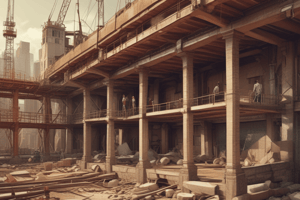Podcast
Questions and Answers
What are the two key factors that determine the properties of materials?
What are the two key factors that determine the properties of materials?
- Chemical composition and mineral composition (correct)
- Chemical composition and physical structure
- Macro-structure and meso-structure
- Mineral composition and micro-structure
What happens to the strength, hardness, and toughness of carbon steel when the carbon content increases?
What happens to the strength, hardness, and toughness of carbon steel when the carbon content increases?
- They decrease
- They change (correct)
- They are unaffected
- They remain the same
Why is stainless steel created?
Why is stainless steel created?
- To increase the strength of carbon steel
- To change the color of carbon steel
- To make carbon steel more resistant to rust (correct)
- To decrease the cost of carbon steel
What is the level of structure that can be identified with a magnifying glass or naked eyes?
What is the level of structure that can be identified with a magnifying glass or naked eyes?
What is the term for the chemical constituents of a material?
What is the term for the chemical constituents of a material?
What are minerals in inorganic materials?
What are minerals in inorganic materials?
What determines the characteristics of cement?
What determines the characteristics of cement?
What are the three levels of material structure?
What are the three levels of material structure?
Why are the compositions of materials important?
Why are the compositions of materials important?
What is the term for the chemical components and structures of minerals?
What is the term for the chemical components and structures of minerals?
At what level is the total material considered continuous and homogeneous?
At what level is the total material considered continuous and homogeneous?
What is the minimum volume of the material that represents the entire material system?
What is the minimum volume of the material that represents the entire material system?
What is the shape of the representative cell if the properties are the same in all directions?
What is the shape of the representative cell if the properties are the same in all directions?
What level of structure can be observed by optical microscope?
What level of structure can be observed by optical microscope?
What is mainly studied in the meso-structure?
What is mainly studied in the meso-structure?
What is the range of linear dimensions of the representative cell for metals?
What is the range of linear dimensions of the representative cell for metals?
What is the size of the wall thickness of a wood cell?
What is the size of the wall thickness of a wood cell?
What is the level of structure that can be studied by electron microscopy and X-ray diffractometer?
What is the level of structure that can be studied by electron microscopy and X-ray diffractometer?
What is the size range of particles in a material at the meso-structure level?
What is the size range of particles in a material at the meso-structure level?
What matters most in the meso-structure level?
What matters most in the meso-structure level?
What is the charge of the nucleus in an atom?
What is the charge of the nucleus in an atom?
What is the primary reason for atoms bonding with each other?
What is the primary reason for atoms bonding with each other?
What type of bond involves the transfer of an electron?
What type of bond involves the transfer of an electron?
What is a characteristic of ionic bonds?
What is a characteristic of ionic bonds?
What type of bond is commonly found in organic molecules?
What type of bond is commonly found in organic molecules?
What is a characteristic of metallic bonds?
What is a characteristic of metallic bonds?
What is the 'sea of electrons' model related to?
What is the 'sea of electrons' model related to?
What is a limitation of ionic bonds?
What is a limitation of ionic bonds?
What is the electrostatic attraction in atoms related to?
What is the electrostatic attraction in atoms related to?
What is the result of atoms bonding with each other?
What is the result of atoms bonding with each other?
Flashcards are hidden until you start studying
Study Notes
Materials Composition and Structure
- Materials composition includes chemical composition and mineral composition, which are key factors for the properties of materials.
- Chemical composition refers to the chemical constituents, and varying chemical compositions result in different properties.
- For example, increasing carbon content in carbon steel changes its strength, hardness, and toughness, making it prone to rust, which can be addressed by adding chromium, nickel, and other chemical components to create stainless steel.
Mineral Composition
- Many inorganic materials consist of various mineral compositions, which are key factors for the properties of some building materials (e.g., natural stone, inorganic gel, and other materials).
- Cement exhibits different characteristics due to different clinkers.
Structure of Materials
- The structures of materials can be divided into macro-structure, meso-structure, and micro-structure, which are key factors related to the properties of materials.
Macro-structure
- Macro-structure refers to the thick structure above millimeter that can be identified with a magnifying glass or naked eyes.
- At the engineering level, the total material is considered, and it is normally taken as continuous and homogeneous, with average properties assumed throughout the whole volume of the material body.
- The minimum scale that must be considered is governed by the size of the representative cell, which varies from 10^(-3) m for metals to 0.1 m for concrete and 1 m for masonry.
Meso-structure
- Meso-structure refers to the micro-level structure that can be observed by optical microscope.
- It includes the size, shape, and interface of grains and particles, and the size, shape, and distribution of pores and micro-cracks.
- The material is considered as a composite of different phases, which interact to realize the behavior of the total material.
Microstructure
- Microstructure refers to the atomic and molecular structures of materials that can be studied by electron microscopy, X-ray diffractometer, and other means.
- Atoms consist of a nucleus surrounded by a cloud of orbiting electrons, and the nucleus consists of positively charged protons and neutral neutrons.
Bonding of Atoms
- Atoms tend to arrange themselves in the most stable patterns possible, which means they have a tendency to complete or fill their outermost electron orbits.
- Ionic bonding involves a transfer of an electron, resulting in high strength, hardness, and melting point, but also volatility and medium density.
- Covalent bonding involves the sharing of electrons between two atoms, resulting in strong bonding force, high strength, hardness, melting point, and density.
- Metallic bonding involves sharing electrons, resulting in volatile strength and hardness, high density, and good thermal and electrical conductivity.
Studying That Suits You
Use AI to generate personalized quizzes and flashcards to suit your learning preferences.




